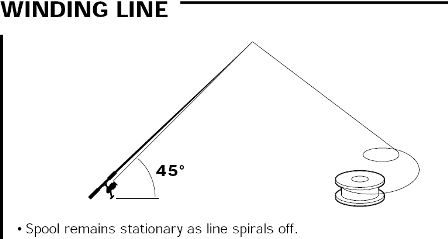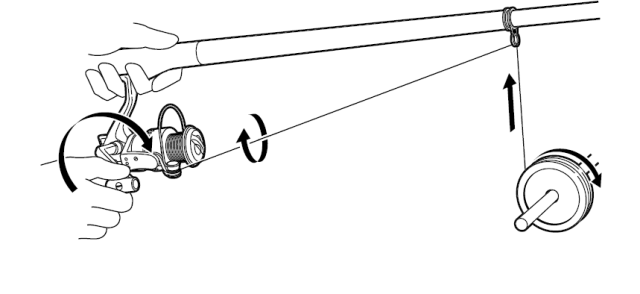How To Wind Fishing Line On A Spinning Reel

A spinning reel can be wound with any high quality line, however, care should be taken to make sure that the line is wound tight from the very start. A loosely or unevenly wound line can cause several problems. The line can slip under the pressure of a fighting fish, causing binding, kinking of the line, and possibly even breakage. Poor line winding can also make casting difficult. To properly install the line, follow these steps:
Step 1. Mount the reel on a rod. This allows you to get a better grip.
Step 2. Place the spool of line on a flat surface with the label facing up. Pull the line off the spool in a counterclockwise fashion and thread the line through the rod guides.
Step 3. Flip the bail open and tie the line to the spool using a slip knot.
Step 4. Tighten the drag to minimize unwanted movement of the spool. (Note: Tighten it only to the point where it can be easily loosened by hand.)
Step 5. Hold the rod at a 45 degree angle and begin winding line under some tension.
Step 6. Wind line onto the spool until the line level is approximately 1/8" below the spool flanges
-or-

PowerRoller spinning reels work best when the line is loaded in the following manner. Place a screwdriver shaft (or something a lot like that) through the center of the spool of line that you're going to load onto your reel. After tying the line to your reel, wind the line on, allowing the spool to turn around the screwdriver shaft (or whatever it is you're using!) - as in the picture.
FILLING THE BAIT CAST REEL SPOOL
A bait cast reel can be used with almost any type of line including monofilament, Dacron, or braided. Whichever line you choose, you should be aware that it must be filled firmly onto the spool. This is accomplished by loading the line under firm and uniform tension. If the line is not wound tightly onto the spool, a fish running off line against a strong drag setting will pull the top-most coil of line down into the lower layers. This embedded line can either lock the spool or damage the line itself. Either situation will probably cause a lost fish through broken line or overrun spool (Big Jim always called an overrun a professional overcast).
Securely anchor your line around the arbor of the spool. Failure to do so may allow the line to slip around the spool under pressure. Many reels have engraved red lines on the spool flange to indicate the optimal line fill level. If not, fill the spool to one quarter to one half inch from the spool edge.